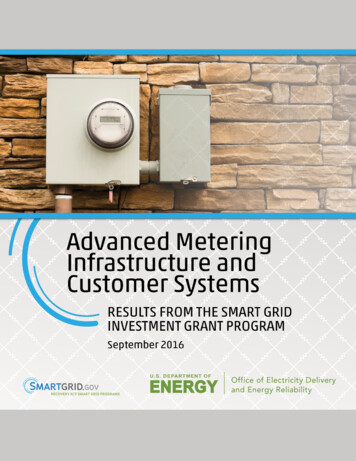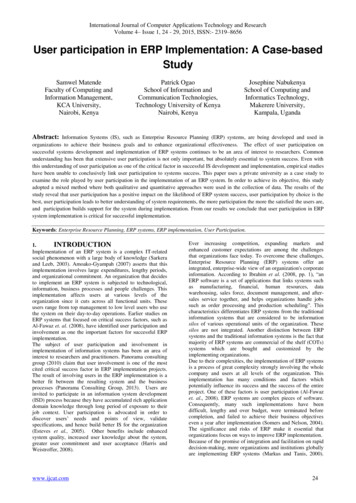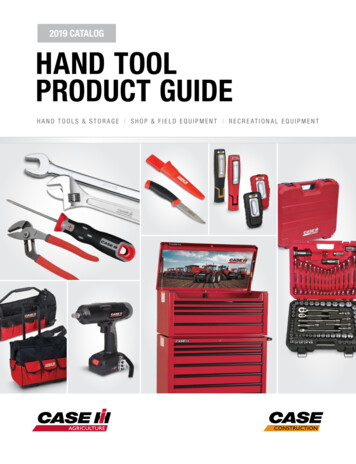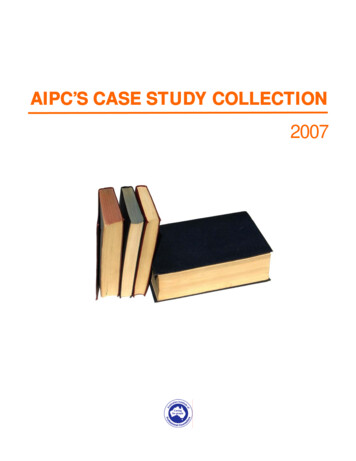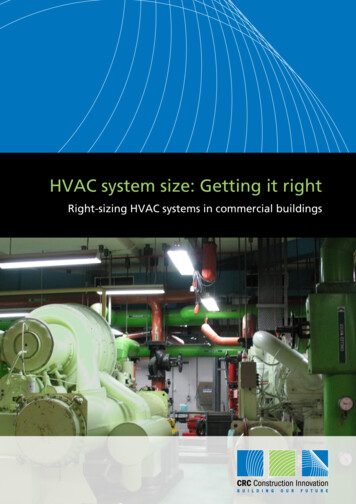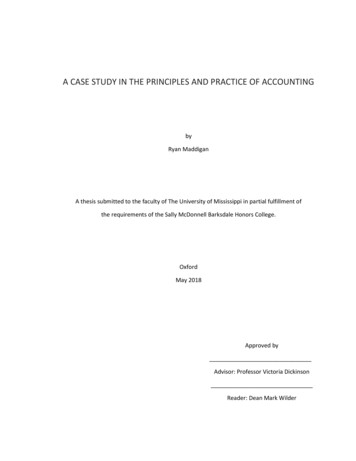
Transcription
A CASE STUDY IN THE PRINCIPLES AND PRACTICE OF ACCOUNTINGbyRyan MaddiganA thesis submitted to the faculty of The University of Mississippi in partial fulfillment ofthe requirements of the Sally McDonnell Barksdale Honors College.OxfordMay 2018Approved byAdvisor: Professor Victoria DickinsonReader: Dean Mark Wilder
ABSTRACTRYAN MADDIGAN: A Case Study in the Principles and Practice of Accounting(Under the direction of Victoria Dickinson)The research for this thesis project is intended to be a comprehensive study onthe various concepts present in the principles and practice of accounting. This includesfinancial analyses and other examinations of financial information for a variety ofdifferent situations and companies using several different measures and concepts. Thegoal of these case studies is to determine accounting best practices based on GAAP foreach company and their effect on the company’s financial statements and reporting.This was determined specifically through analysis by comparison of accounting ratios onprofitability, liquidity, turnover, financial leverage and dividend policy as well asexamination and application of the accounting standards found in the FASB AccountingStandards Codification. Topics include the effects of accounting estimates, incomestatement/balance sheet/statement of cash flows presentation, accounting for baddebts, accounting for inventory impairments as well as accounting for leases, amongothers. In addition to the analyses on financial reporting, included is an analysis of acase regarding internal control procedures and their implementation. I found that thesituations presented by the cases were an excellent summation of the knowledge I haveacquired over the course of my accounting studies and that the cases both furtheredthat knowledge and provided a way of applying that knowledge. But overall, Idetermined that accounting knowledge and research can be applied in number of waysand that using a variety of different methods and tools to analyze transactions andfinancial data provides the most thorough and accurate results.iii
TABLE OF CONTENTSCASE 1 .1CASE 2 .18CASE 3 .27CASE 4 .33CASE 5 .35CASE 6 .40CASE 7 .44CASE 8 .48CASE 9 .52CASE 10 .58CASE 11 .63CASE 12 .67REFERENCES .73iii
Case 1Financial Analysis of Glenwood Heating, Inc. and Eads Heaters, Inc.By Ryan Maddigan1
Executive Summary:In this case one will find the charts of accounts, financial statements, and profitability ratios that serve to compare thefinancial success and potential for investment or lending for the two heater companies, Glenwood Heating, Inc. and Eads Heater,Inc. After analysis of their transactions and financial statements, it is clear that Glenwood Heating is the superior investing and/orlending partner, as it seems to be significantly more profitable in comparison to Eads.Table 1-2Home HeatersPart A: Recording BasicTransactionsAssetsNo. 1No. 2No. 3No. 4No. 5No. 6No. 7No. 8No. 9No. 10No. 11No. tsReceivableInventory LandBuilding70,000350,000Equipment 47,340 InterestPayableStockholders'EquityCommon 98,500{213,360}{20,000} 99,400 239,800 70,000 350,000 80,0002 26,440 380,0006,650 6,650 160,000{21,000}{34,200}{23,200}{6,650} 313,450
Table 1-2Glenwood Heating Inc.Part B: Recording Additional InformationAssetsTransactionBalances: Part APart B (1): Bad DebtsPart B (2): COGSPart B (3): DepreciationBuildingEquipmentPart B (4): EquipmentRental PaymentPart B (5): Income TaxBalancesTransactionBalances: Part APart B (1): Bad DebtsPart B (2): COGSPart B (3): DepreciationBuildingEquipmentPart B (4): EquipmentRental PaymentPart B (5): Income anceFor 9,000}{16,000}{30,914} 426 380,000 {994} 62,800 70,000 350,000Owners' 4}{177,000}InterestPayable6,650{10,000}{9,000} 26,440 380,000 6,650 160,0003{16,000}{30,914} 69,542 {10,000} 80,000 {9,000}
Table 1-3Glenwood Heating, Inc.Income StatementFor Year Ended December 31, 20X1Sales RevenueCost of Goods SoldGrossProfitBad Debt ExpenseDepreciationExpenseRentExpenseOther Operating Expenses398,500{177,000}Income From OperationsInterest Expense151,306{27,650}Income From Continuing Operations (Before 16,000}{34,200}{30,914} 92,7424
Table 1-4Glenwood Heating, Inc.Statement of Retained EarningsFor Year Ended December 31, 20X1TotalRetainedEarningsCommon StockBeginning BalanceNetIncome160,0000160,00092,74269,5420Ending Balance 252,742 69,542 160,0005
Table 1-5Glenwood Heating, Inc.Classified Balance SheetFor Year Ended December 31, Allowance ForBad DebtsInventoryTotalCurrentAssetsProperty,Plant, onEquipmentLess:AccumulatedDepreciationTotal Property,Plant, 70,000350,000{10,000}80,000{9,000}Liabilities and leInterest on NotePayableTotal CurrentLiabilitiesLong TermLiabilitiesNotes PayableTotal Long TermLiabilitiesTotal LiabilitiesStockholders'EquityCommon StockRetainedEarningsTotal Stockholders'EquityTotal Liabilities andStockholders' 069,542229,542 642,632481,000 642,6326
Table 1-6Glenwood Heating, Inc.Statement of Cash FlowsFor Year Ended December 31, 20X1Cash Flows from Operating ActivitiesNet IncomeAdjustments:Depreciation ExpenseBad Debt ExpenseAccounts ReceivableInventoryAccounts PayableInterest PayableNet Cash Flows From Operating ActivitiesCash Flows From Investing ActivitiesLand PurchaseBuilding PurchaseEquipment PurchaseNet Cash Flows From Investing ActivitiesCash Flows From Investing ActivitiesProceeds From Borrowing on Note PayableProceeds From Issuance of Common StockPayment of Cash DividendNet Cash Flows From Financing ActivitiesTotal Net Cash 000{23,200}516,800 4267
Table 1-7Eads Heater Inc.Part B: RecordingAdditional InformationAssetsTransactionBalances: Part APart B (1): Bad DebtsPart B (2): COGSPart B (3): DepreciationBuildingEquipmentPart B (4): EquipmentLeaseLease PaymentDepreciationPart B (5): Income TaxBalancesCash47,340AllowanceFor BadDebts tionBuilding{10,000}{16,000}{23,505} 7,835 99,400 {4,970}8 51,000 70,000 350,000 {10,000}
Table ionLease{20,000}TransactionBalances: Part APart B (1): Bad DebtsPart B (2): COGSPart B (3): DepreciationBuildingEquipmentPart B (4): EquipmentLeaseLease PaymentDepreciationPart B (5): Income TaxBalancesOwners' EquityCommonStock160,00092,000{11,500} 80,000 {20,000} 380,000InterestPayable6,65092,000{8,640} 26,440 380,000 6,650RetainedEarnings313,450{4,970}{188,800} {11,500}{10,000}{20,000} 160,0009LeasePayable{7,360}{11,500}{23,505} 47,315 83,360
Table 1-8Eads Heater, Inc.Income StatementFor Year Ended December 31, 20X1Sales Revenue398,500Cost of Goods SoldGrossProfit{188,800}Bad Debt ExpenseDepreciationExpense{4,970}{41,500}Other Operating Expenses{34,200}Income From Operations129,030Interest Expense{35,010}209,700Income From Continuing Operations (Before Tax)IncomeTaxNetIncome94,020{23,505} 70,51510
Table 1-9Eads Heater, Inc.Statement of Retained EarningsFor Year Ended December 31, 20X1RetainedTotalCommonEarningsStockBeginning Balance160,0000160,000Net Income70,51547,3150 230,515 47,315 160,000Ending Balance11
Table 1-10Eads Heater, Inc.Classified Balance SheetFor Year Ended December 31, 20X1AssetsCurrent AssetsCash7,835Accounts Receivable99,400Less: Allowance For Bad Debts{4,970}Inventory51,000Total Current Assets153,265Property, Plant, and EquipmentLand70,000Building350,000Less: Accumulated Depreciation{10,000}Equipment80,000Less: Accumulated Depreciation{20,000}Leased Equipment92,000Less: Accumulated Depreciation{11,500}Total Property, Plant, and Equipment550,500Total Assets 703,76512
Liabilities and Stockholders' EquityTable 1-10 ContinuedCurrent LiabilitiesAccounts Payable26,440Interest on Note Payable6,650Total Current Liabilities33,090Long Term LiabilitiesNotes Payable380,000Lease Payable83,360Total Long Term Liabilities463,360Total Liabilities496,450Stockholders' EquityCommon Stock160,000Retained Earnings47,315Total Stockholders' Equity207,315Total Liabilities and Stockholders' Equity 703,76513
Table 1-11Eads Heaters, Inc.Statement of Cash FlowsFor Year Ended December 31, 20X1Cash Flows from Operating ActivitiesNet IncomeAdjustments:Depreciation ExpenseBad Debt ExpenseAccounts ReceivableInventoryAccounts PayableInterest PayableNet Cash Flows From Operating ,650{325}Cash Flows From Investing ActivitiesLand PurchaseBuilding PurchaseEquipment PurchaseNet Cash Flows From Investing Activities{70,000}{350,000}{80,000}{500,000}Cash Flows From Investing ActivitiesProceeds From Borrowing on Note PayableProceeds From Issuance of Common StockPayment of Cash DividendPayment on Principle of LeaseNet Cash Flows From Financing ActivitiesTotal Net Cash Flows380,000160,000{23,200}{8,640}508,160 7,83514
Glenwood Heating, Inc. Profitability RatiosGross Profit Margin:55.58%Profit Margin:23.27%Debt Ratio:64.28%Return on Assets:14.43%Times Interest Earned:5.47Return on Equity:57.96%Eads Heater, Inc. Profitability RatiosGross Profit Margin:52.62%Profit Margin:17.70%Return on Assets:10.02%Return on Equity:Debt Ratio:Times Interest Earned:70.54%3.6944.07%Conclusion:It appears that Glenwood Heating is in better financial shape than Eads Heater. Although Eads has a higher cash flow for bothoperating activities and in total, Glenwood in almost every other aspect is more profitable on an operational level. This is evident inthe fact that it has more net income and retained earnings than its competitor but also seems to be performing better in profitabilityratio tests. Its profit margin and gross profit margin are both higher than Eads while also it seems to be more efficient with its assets15
as well as its shareholders’ equity, providing a superior return. Overall it seems to be in a more sound financial position, as its debtratio is lower than Eads Heater and can pay off its interest 5.47 times over compared with 3.69 times interest earned from Eads. Forthese reasons I would recommend investing in or lending money to Glenwood Heating, Inc. rather than Eads.On my honor, I pledge that I have neither given, received, nor witnessed any authorized help on this case study.Signed: Ryan Maddigan16
AppendixGlenwood Profitability Ratios (Calculations)1. Gross Pofit Margin: (Revenue - COGS)/ Revenue(398,500 – 177,000)/ 398,500 55.58%2. Profit Margin: Net Income/ Net Sales92,742/398,500 23.27%3. Return on Assets: Net Income/ Average total assets92,742/642,632 14.43%4. Return on Equity: Net Income/ Shareholders’ Equity92,742/160,000 57.96%5. Debt Ratio: Total liabilities/ Total assets413,090/642,632 64.28%6. Times Interest Earned: Income before interest and taxes/ Interest expense151,306/27,650 5.47Eads Profitability Ratios (Calculations)1. Gross Pofit Margin: (Revenue - COGS)/ Revenue(398,500 – 188,800)/ 398,500 52.62%2. Profit Margin: Net Income/ Net Sales70,515/398,500 17.70%3. Return on Assets: Net Income/ Average total assets70,515/703,765 10.02%4. Return on Equity: Net Income/ Shareholders’ Equity70,515/160,000 44.07%5. Debt Ratio: Total liabilities/ Total assets496,450/703,765 70.54%6. Times Interest Earned: Income before interest and taxes/ Interest expense129,030/35,010 3.6917
Case 2Totz: Guidance on Appropriate Income StatementPresentationBy Ryan Maddigan18
1.Regulation S-X Rule 5-03, Income Statements (Codification 225-10-S99-2) “(b) If income is derived from more than one of the subcaptions described under§ 210.5–03.1, each class which is not more than 10 percent of the sum of theitems may be combined with another class. If these items are combined, relatedcosts and expenses as described under § 210.5–03.2 shall be combined in thesame manner.” 1. Net sales and gross revenues. State separately:o (a) Net sales of tangible products (gross sales less discounts, returns andallowances),o (b) operating revenues of public utilities or others;o (c) income from rentals;o (d) revenues from services; ando (e) other revenues.”According to Regulation S-X Rule 5-03, one should state net sales of tangible products,with revenues from services to be stated separately from those net sales on theincome statement because each category is more than ten percent of the sum of theitems.19
2.Costs and Expenses (Codification 270-10-45-4) “Costs and expenses for interim reporting purposes may be classified as either ofthe following:o Costs associated with revenue - those costs that are associated directly withor allocated to the products sold or to the services rendered and that arecharged against income in those interim periods in which the related revenueis recognized.”Regulation S-X Rule 5-03, Income Statements (Codification 225-10-S99-2) “2. Costs and expenses applicable to sales and revenues.State separately the amount of (a) cost of tangible goods sold, (b) operating expenses of public utilities or others, (c) expenses applicable to rental income, (d) cost of services, and (e) expenses applicable to other revenues.”20
SAB Topic 11.B, Depreciation and Depletion Excluded from Cost of Sales (Codification225-10-S99-8) “Facts: Company B excludes depreciation and depletion from cost of sales in its incomestatement. Question: How should this exclusion be disclosed? Interpretive Response: If cost of sales or operating expenses exclude charges fordepreciation, depletion and amortization of property, plant and equipment, thedescription of the line item should read somewhat as follows: "Cost of goods sold(exclusive of items shown separately below)" or "Cost of goods sold (exclusive ofdepreciation shown separately below)." To avoid placing undue emphasis on "cashflow," depreciation, depletion and amortization should not be positioned in the incomestatement in a manner which results in reporting a figure for income beforedepreciation.”According to Codification 270-10-45-4, costs and expenses directly associated withproducts sold or to the services rendered would be classified under costs associatedwith revenue. Being that costs such as product costs, freight-in, import costs, anddirect labor costs are all directly associated with the products sold/services renderedand fall under the categories of either tangible goods or cost of services, they shouldbe stated separately on the income statement in accordance with the second sectionof Regulation S-X Rule 5-03. Also, with regard to depreciation being excluded from21
cost of sales in the income statement, SAB Topic 11.B instructs an accountant to makenote of its exclusion in the line item.3.Accounting Standards Update No. 2015-01—Income Statement—Extraordinary andUnusual Items (Subtopic 225-20)“The objective of this Update is to simplify the income statement presentationrequirements in Subtopic 225-20 by eliminating the concept of extraordinary items.Extraordinary items are events and transactions that are distinguished by their unusualnature and by the infrequency of their occurrence. Eliminating the extraordinaryclassification simplifies income statement presentation by altogether removing theconcept of extraordinary items from consideration.”Presentation of Unusual or Infrequently Occurring Items (Codification 225-20-45-16)“A material event or transaction that is unusual in nature or occurs infrequently but notboth, and therefore does not meet both criteria for classification as an extraordinaryitem, shall be reported as a separate component of income from continuing operations.The nature and financial effects of each event or transaction shall be disclosed on theface of the income statement or, alternatively, in notes to financial statements. Gains orlosses of a similar nature that are not individually material shall be aggregated. Suchitems shall not be reported on the face of the income statement net of income taxes or22
in any other manner that may imply that they are extraordinary items. Similarly, the EPSeffects of those items shall not be presented on the face of the income statement.”Criteria for Presentation as Extraordinary Items (Codification 225-20-45-1 and 2)“Judgment is required to segregate in the income statement the effects of events ortransactions that are extraordinary items (as required by paragraphs 225-20-45-10through 45-11). An event or transaction shall be presumed to be an ordinary and usualactivity of the reporting entity, the effects of which shall be included in income fromoperations, unless the evidence clearly supports its classification as an extraordinaryitem as defined in this Subtopic. a. Unusual nature: The underlying event or transaction should possess a high degree ofabnormality and be of a type clearly unrelated to, or only incidentally related to, theordinary and typical activities of the entity, taking into account the environment inwhich the entity operates. b. Infrequency of occurrence: The underlying event or transaction should be of a typethat would not reasonably be expected to recur in the foreseeable future, taking intoaccount the environment in which the entity operates.”According to Codification 225-20-45-16, “a material event or transaction that isunusual in nature or occurs infrequently but not both ” is an unusual event, whileextraordinary events, which were considered both unusual and infrequent, wereeliminated from consideration in Accounting Standards Update No. 2015-01. Since the23
sale of company headquarters could be reasonably considered infrequent, one of thetwo requirements outlined in Codification 225-20-45-2 are met, which is enough toconsider it an unusual event. The transaction should then be classified as such.Therefore the 1.7 million gain on sale of building should be reported as a separatecomponent under operating income and the nature of the transaction describedeither on the face of in the transaction or in the notes.4.Presentation of Unusual or Infrequently Occurring Items (Codification 225-20-45-16)“A material event or transaction that is unusual in nature or occurs infrequently but notboth, and therefore does not meet both criteria for classification as an extraordinaryitem, shall be reported as a separate component of income from continuingoperations. The nature and financial effects of each event or transaction shall bedisclosed on the face of the income statement or, alternatively, in notes to financialstatements. Gains or losses of a similar nature that are not individually material shall beaggregated. Such items shall not be reported on the face of the income statement net ofincome taxes or in any other manner that may imply that they are extraordinaryitems. Similarly, the EPS effects of those items shall not be presented on the face of theincome statement.”Regulation S-X Rule 5-03, Income Statements (Codification 225-10-S99-2)24
“7. Non-operating income. State separately in the income statement or in a notethereto amounts earned fromo(a) dividends,o(b) interest on securities,o(c) profits on securities (net of losses), ando(d) miscellaneous other income. Amounts earned from transactions in securities of related parties shall be disclosed asrequired under § 210.4–08(k). Material amounts included under miscellaneous otherincome shall be separately stated in the income statement or in a note thereto,indicating clearly the nature of the transactions out of which the items arose.”According to Accounting Standards Update No. 2015-01, extraordinary items areeliminated. So since it is not classified as extraordinary, it should simply be classifiedas unusual. And according to the previously cited Codification 225-20-45-16, it shall bereported as a separate component of income from continuing operations under nonoperating income. In this case it would most likely fall under “miscellaneous otherincome” as noted in Regulation S-X Rule 5-03 and the details of the 2.7 million gainfrom the class action lawsuit should either be stated separately or in the footnotes.25
On my honor, I pledge that I have neither given, received, nor witnessed any authorizedhelp on this case study.Signed: Ryan Maddigan26
Case 3Rocky Mountain Chocolate FactoryBy Ryan Maddigan27
Rocky Mountain Chocolate Factory, Inc.Journal EntriesFor Fiscal Year 20101. Inventories7,500,000Accounts Payable2. Inventories7,500,0006,000,000Accrued Salaries and Wages3. Cash and Cash EquivalentsAccounts 000Cost of Sales14,000,000Inventories4. Accounts Payable14,000,0008,200,000Cash and Cash Equivalents5. Cash and Cash Equivalents8,200,0004,100,000Accounts Receivable6. Sales and Marketing ExpensesGeneral and Admin ExpensesRetail Operating Expenses4,100,0001,505,4312,044,5691,750,000Cash and Cash EquivalentsOther Accrued Expenses7. Accrued Salaries and Wages2,000,0003,300,0006,423,789Cash and Cash Equivalents8. Cash and Cash Equivalents6,423,789125,000Deferred Income9. Property and Equipment, Net125,000498,832Cash and Cash Equivalents10. Retained Earnings498,8322,407,167Cash and Cash EquivalentsDividends Payable282,403,4583,709
Journal Entries, Continued11. Cash and Cash EquivalentsNotes Receivable, CurrentDeferred Income TaxesProperty and Equipment, NetNotes Receivable, Less CurrentOther Accrued ExpensesDividend PayableDeferred IncomeCost of SalesFranchise CostsIncome Tax 46,062693,7861,499,4772,090,468Accounts ReceivableInventoriesOther Current AssetsIntangible Assets, NetOther Long Term AssetsAccounts PayableDeferred Income TaxesCommon StockAdditional Paid-In-CapitalSalesFranchise and Royalty FeesGeneral and AdministrativeIncome Tax Expense12. Cost of tories13. Depreciation and Amortization Expense216,836698,580Property and Equipment, Net14. General and Administrative ExpenseRetail Operating Expense698,580639,2006,956Accrued Salaries and Wages646,15615. No Entry16. SalesFranchise and Royalty FeesInterest Income22,944,0175,492,53127,210Cost of SalesFranchise CostsSales & MarketingGeneral and AdministrativeRetail OperatingDepreciation and AmortizationIncome Tax ExpenseRetained 56,956698,5802,090,4683,580,077
AccountCash and Cash EquivalentsAccounts ReceivableNotes Receivable, CurrentInventoriesDeferred Income TaxesOtherProperty and Equipment, NetNotes Receivable, Less CurrentGoodwill, NetIntangible Assets, NetOtherAccounts PayableAccrued Salaries and WagesOther Accrued ExpensesDividend PayableDeferred IncomeDeferred Income TaxesCommon StockAdditional Paid-In-CapitalRetained EarningsSalesFranchise and Royalty FeesCost of SalesFranchise CostsSales and MarketingGeneral and AdministrativeRetail OperatingDepreciation and AmortizationInterest IncomeIncome Tax ExpenseA L OE R - E11. All OtherTransactions10. DividendsDeclared and Paid9. Purchase PPE8. Receive FranchiseFees7. Pay Wages6. Incur SG&A (Cashand Payable)5. CollectReceivables4.Pay for Inventory3. Sell Inventory forCash and OnAccount2. Incur FactoryWages1. PurchaseInventoryBeginning Balance(February 5800639,2006,956646,156015. ,58027,210-2,090,46816. Closing Entry14,000,00022,000,000-8,200,000-698,58014. Wage Accrual07,500,000Unadjusted TrialBalance-73,110-3,007503,18912. Adjust forInventory Count3,743,0924,427,52691,0593,498,283 8087,626,6023,343,85022,944,0175,492,53114,693,786 02,090,4680013. RecordDepreciation17,000,000 -8,200,000 4,100,000 -2,000,000 -6,423,789 125,000 -498,832 -2,403,458 790,2245,000,000-4,100,000-702,20791,0597,500,000 6,000,000 8Pre-Closing ing) Balance
Transaction1. Purchase Inventory2. Incur Factory Wages3. Sell Inventory (Cash and Account)4. Pay For Inventory5. Collect Receivables6. Incur SG&A (Cash and Payable)7. Pay Wages8. Receive Franchise Fees9. Purchase PPE10. Dividends Declared/Paid11. All Other Transactions12. Inventory Count Adjustment13. Record Depreciation14. Wage Accrual15. Consultant's ReportClassificationOperating ActivityOperating ActivityOperating ActivityOperating ActivityOperating ActivityOperating ActivityOperating ActivityOperating ActivityInvesting ActivityFinancing ActivityN/AOperating ActivityOperating ActivityOperating ActivityN/ARocky Mountain Chocolate Factory, Inc.Income StatementFor Year Ended February 28, 2010SalesFranchise and Royalty FeesTotal Revenues22,944,0175,492,531Cost of SalesFranchise CostsSales & MarketingGeneral and AdministrationRetail OperatingDepeciation and AmortizationTotal Operating ExpensesInterest IncomeIncome Before TaxIncome Tax ExpenseNet 4683,580,07728,436,54831
Rocky Mountain Chocolate Factory, Inc.Balance SheetFor Year Ended February 28, 2010AssetsCurrent AssetsCash and Cash EquivalentsAccounts ReceivableNotes Receivable, CurrentInventoriesDeferred Income TaxesOther Current AssetsTotal Current AssetsLong Term AssetsProperty and Equipment, NetNotes Receivable Less CurrentGoodwill, NetIntangible Assets, NetOther Long Term AssetsTotal Long Term AssetsTotal 06,695,37818,919,914Liabilities and Stockholders' EquityCurrent LiabilitiesAccounts PayableAccrued Salaries and WagesOther Accrued ExpensesDividend PayableDeferred IncomeTotal Current LiabilitiesDeferred Income TaxesTotal 4,148894,4294,188,577Stockholders' EquityCommon StockAdditional Paid-In-CapitalRetained EarningsTotal Stockholders' EquityTotal Liabilities and Stockholders' 4On my honor, I pledge that I have neither given, received, nor witnessed any authorizedhelp on this case study.Signed: Ryan Maddigan32
Case 4Consulting GroupGroup 2Parker DurhamRachel RutledgeMary Elizabeth GentryAllison FloydRyan MaddiganSwede Umbach33
Executive Summary:Kayla, thank you for hiring Group 2 Consulting Group, LLC. We have evaluated your operationsand have identified areas where fraud might occur. Along with these identified areas, we haveprovided our recommendations of internal control that will help eliminate these possibilities offraud. Please see our recommendations in the table provided below.Problem Susceptible to FraudLucy records daily sales and prepares thecorresponding bank deposits.While the automatic update of the perpetualinventory system is efficie
examination and application of the accounting standards found in the FASB Accounting Standards Codification. Topics include the effects of accounting estimates, income statement/balance sheet/statement of cash flows presentation, accounting for bad debts, accounting for inventory impairments as well

